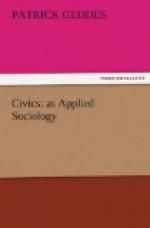Apart altogether from what may be the quality and defects of particular volumes, such as those cited as examples of each part of such a proposed civic trilogy, one as yet nowhere complete, the very conception of such a possible threefold series may be of some service. For this would present a continuous whole, at once sociological and civic—the views and the resources of the scholar and the educationist with their treasures of historic culture, of the man of action with his mastery of immediate affairs, of the thinker with his vision of the opening future, now all co-ordinated by help of the design of the artist, and thence to be gradually realised in the growing heritage of the city, the enlarging life of the citizen.
Note—As an example of the concrete application to a particular city, of the sociological methods and principles indicated in the above paper, Prof. Geddes exhibited an illustrated volume embodying the results of his studies and designs towards the improvement of Dunfermline, under the Trust recently established by Mr. Carnegie. This has since been published:
P. Geddes. City Development. Park Gardens and Culture Institutes; a Report to the Carnegie Dunfermline Trust. With 138 illustrations. Edinburgh, etc.. 1904.
[Page: 119] Discussion
The Chairman (Mr. Charles Booth) in opening the discussion said:
The paper we have just heard read is one of the most complete and charming papers on a great and interesting subject I have ever heard. I think you will all agree in this, and I hope the discussion which follows will emphasise and, if that is possible, add to the wealth of ideas that this paper contains.
Mr Ebenezer Howard (Founder of the Garden City Association) said:
I have read and re-read—in the proof forwarded to me—Professor Geddes’ wonderfully luminous and picturesque paper with much interest. He has given us a graphic description of the geographic process which leads to the development of the city. We see vividly the gradual stages by which the city grows and swells, with the descent of the population from the hillsides into the valleys, even as the river which flows through the city is fed continually by the streams which flow down to it. But is there not this essential difference between the gathering waters of heaven, as they pour into the great city, and the gathering tide of population, which follows the path of the waters? The waters flow through the city on, on toward the mighty ocean, and are then gradually gathered upward into the soft embraces of the clouds and wafted back again to the hills, whence they flow down once more to the valleys. But the living stream of men, women, and children flows from the country-side and leaves it more and more bare of active, vigorous, healthy life: it does not, like the waters, “return again to cover the earth,” but moves ever on to the great city,




